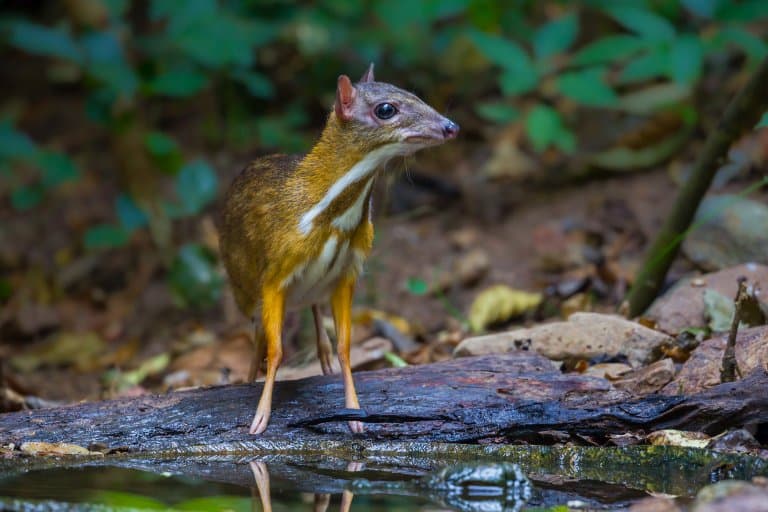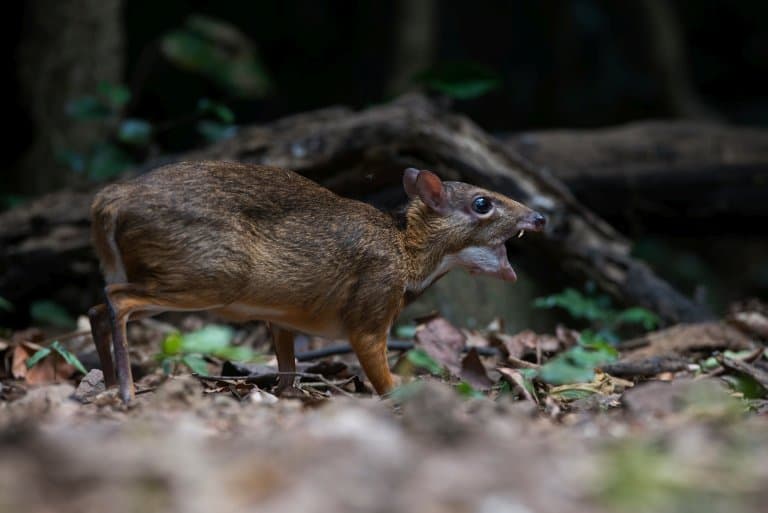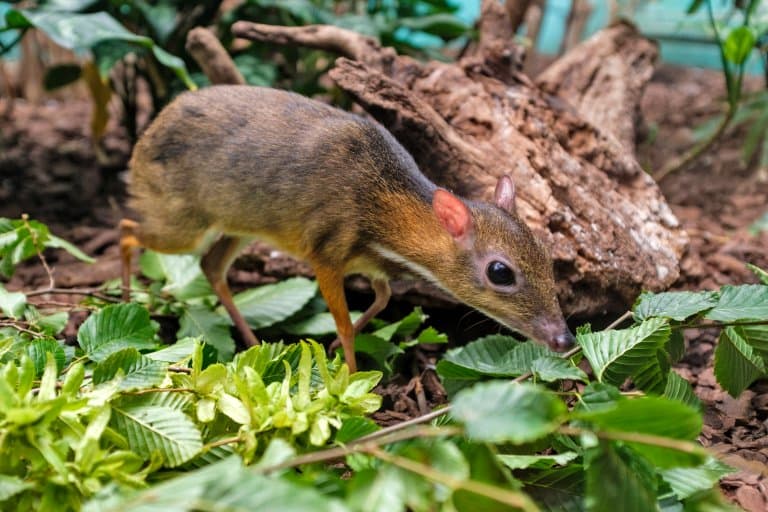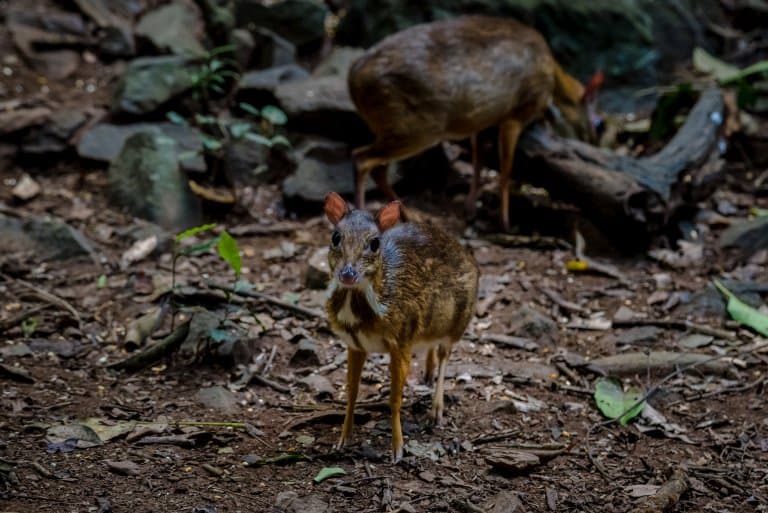Chevrotain Profile
In the understory of many patches of forest in Southeast Asia, you’d be very lucky to spot the world’s smallest hooved animal. These tiny little critters are bovids and ruminants, but they don’t look it.
Known commonly as the mouse deer, this is neither a deer nor a mouse, but a fanged, ancient mammal that’s so elusive, that’s about all we know of the chevrotain.

Chevrotain Facts Overview
| Habitat: | Forests |
| Location: | South and Southeast Asia |
| Lifespan: | 16 years + in captivity |
| Size: | Roughly 75cm (29 inches) long, 34cm (13 inches) tall |
| Weight: | Largest species weighs around 15kg (33lb) |
| Colour: | Usually brown with a white neck and belly |
| Diet: | Fruit, berries aquatic plants and leaves |
| Predators: | Many larger predators: cats, raptors, snakes, crocodiles |
| Top Speed: | Fast in bursts |
| No. of Species: | 10 |
| Conservation Status: | Data Defficient to Endangered |
There are at least ten extant species of chevrotain, though they used to be common worldwide. Most of these species are found in forests across Southeast Asia, only the water chevrotain inhabits the rainforests of central and west Africa.
They are largely solitary creatures, and are herbivores that diet exclusively on plants.
Their primitive design and tiny size have led to their demise at the hands of much newer models of mammalian design over the last few million years, but those who survive are remarkably unchanged, and represent a different world entirely.
They don’t have many of the same strategies modern ruminants use to survive, instead, they have their own. And some are so effective they manage to keep even the most persistent researchers at bay.
Interesting Chevrotain Facts
1. They’re living fossils
For a ruminant – a herbivore that ferments its food in special gastric chambers like a cow or a sheep – chevrotains are a peculiar example.
They’re much closer to the prehistoric ancestor of modern ruminants than any other species alive today and have some primitive features (or lack thereof) to prove it.
Firstly, they have four toes on their feet, which is a weird way of having a hoof but was much more common back in the day. Today, most ruminants have two-toed feet.
They also have one fewer fermentation chamber, just like a camel does, whereas the modern ruminants have four. Then, the females are larger than the males, something that is again unusual among ruminants.
Primitive ruminants also never evolved horns, and so the chevrotain is lacking in the characteristic headgear of most of its cousins. But they have a solution to this.
2. They have tusks, which are upper canines
This lack of antlers leaves them very little in the way of weaponry, which, as a deer-like mammal, they clearly need to establish, which of the males is the most epic.
To solve this problem, they’ve evolved tusks. Some are larger than others, but in all species, the male’s are bigger, and this suggests they’re used for fighting.
These tusks, like all tusks, are protruding teeth that come from the jaw and exit the mouth. In this case, the upper canines. Some are curved backwards, some are straight and pointed, leading to another nickname for the chevrotain: the vampire deer. 1

3. They’re the smallest hoofed mammals in the world
Another unique characteristic among ruminants, and indeed ungulates in total, is the diminutive stature of the chevrotain. In fact, they’re bordering on minuscule. They’re rarely more than a foot tall (and as ungulates, they’re already standing on tip toes), and can be as little as a rabbit.
The the Java mouse-deer is the smallest ungulate (hoofed) mammal at just 45cm in length and 30cm in height and weighing between 1-2 kg.
They probably taste just as good, too, and this makes them prime targets for predators who will usually much any animal smaller than they are.
So, they have to be stealthy and elusive, and this, fortunately, is very effective. 2

4. They’re good drummers
While they don’t have a lot in the way of physical intimidation tactics, they aren’t opposed to giving it a try once in a while.
When they’re not behaving with their characteristic timidity, or frozen in place entirely, their tiny rear hooves are able to stamp on the ground up to seven times a second, creating a warning sound for any relevant stakeholders to take note of.
When surprised, they’re able to disappear with very little warning. And at least one variety can make a very wet getaway. 3
5. They’re hard to find
Species such as the water chevrotain have evolved to retreat to the aquatic environment as a defence and are capable of staying under the water for four minutes until the threat is gone.
They’re even capable of walking along the substrate like a tiny hippo, so as to emerge somewhere totally out of sight.
Many species are nocturnal, which is a tried and tested defence against a lot of predation, and others are just super good at hiding.
They typically spend most of their time alone, and this not only reduces their presence for potential hunters but also makes them a bit tricky to research.
The Silver-backed chevrotain, Tragulus versicolor, was long thought extinct in its native habitat in Vietnam when a hunter killed what was thought to have been the last one in 1990.
Since then, however, in 2019, a camera trap picked up one of the elusive miniatures sniffing about in the undergrowth.
The evidence is unmistakable: they’re still there! But nothing much more than this is known about them, and they, along with many other species of Chevrotain, are listed as Data Deficient by the IUCN.
Fortunately, only one of the ten species with enough information for an assessment is listed as endangered, with most seemingly comfortable in the Least Concern category. Though, populations of most species are thought to be in decline. 4
6. They’re not very good parents
Well, this depends on how you look at it. In some ways, the sheer prolific nature of the female chevrotain’s perpetual pregnancies makes them good parents. They spend most of their fertile lives pregnant, breeding year-round, and mating immediately after evicting the previous tenant; sometimes within hours.
But in terms of role models, they don’t really have a lot to impart. Fawns are usually left hidden in a ditch while the mother feeds and navigates her world, and around the time they’re weaned, at around three months old, they’re on their own.
And a month or two later, up to ten months old, the females will become sexually mature and restart the cycle. 5
7. They’re not social, but quite tolerant
While they are generally solitary, their ranges aren’t all that large, and can often overlap. Males will fight occasionally (and scream while they do it) but in general they tend to tolerate each others’ presence to a degree.
If they have anything to say to one another, they prefer to do it by smell

8. They communicate with special glands on their faces
Much like the duikers, chevrotains have powerful scent glands on their faces, this time, under the chin.
Both sexes use these to let others know where they are and what their intentions are. Males, consequently, mark quite a bit when they’re ready to mate.
9. Their name ‘chevrotain’ and ‘mouse-deer’ have been used interchangeably
Though more recently, it’s becoming more accepted to typically refer to species with pale-spotted or striped upper parts as ‘chevrotain’, and without as ‘mouse-deer’.
The word ‘chevrotain’ comes from the Middle French word ‘chevrot’ (meaning fawn), which was originally derived from the word chèvre (meaning goat).
Chevrotain Fact-File Summary
Scientific Classification
| Kingdom: | Animalia |
| Phylum: | Chordata |
| Class: | Mammalia |
| Order: | Artyodactyla |
| Family: | Tragulidae |
| Genus: | Hyemoschus Moschiola Tragulus |
| Species Names: | Water chevrotain, (Hyemoschus aquaticus) Indian spotted chevrotain, (Moschiola indica) Sri Lankan spotted chevrotain, (Moschiola meminna) Yellow-striped chevrotain, (Moschiola kathygre) Java mouse-deer, (Tragulus javanicus) Lesser mouse-deer or kanchil, (Tragulus kanchil) Greater mouse-deer, (Tragulus napu) Philippine mouse-deer, (Tragulus nigricans) Vietnam mouse-deer, (Tragulus versicolor) Williamson’s mouse-deer, (Tragulus williamsoni) |
Fact Sources & References
- “Tragulidae chevrotains and mouse deer”, Animal Diversity Web.
- “LARGER MALAY MOUSE-DEER”, Smithsonian’s National Zoo & Conservation Biology Institute.
- “Tragulus napu Greater Malayan chevrotain”, Ultimate Ungulate.
- Jeremy Hance (2019), “Scientists rediscover mammalian oddity in remote Vietnam”, Mongabay.
- “GREATER MALAYAN CHEVROTAIN TRAGULUS NAPU”, Phoenix Zoo.
